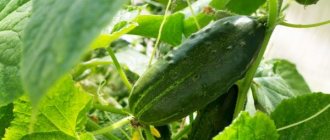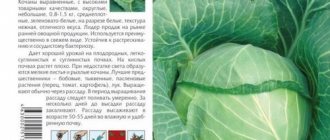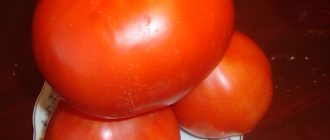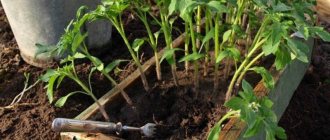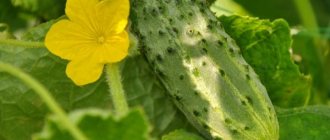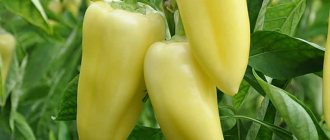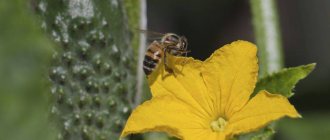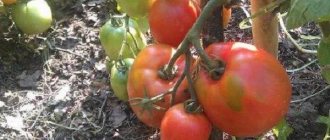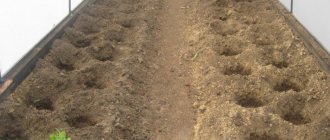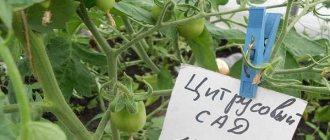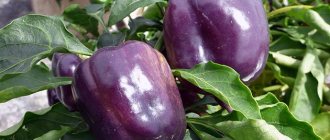Zador F1 is an improved early ripening variety of parthenocarpic cucumbers. It is cultivated in greenhouses and open areas throughout the country. It is of particular interest for cultivation for industrial purposes due to its high and stable yield.
| Landing location | Ripening time | Mode of application | Fruit length | Group | Fruit smoothness | Pollination method |
| Universal | Early ripening (35-45 days) | Universal | Short (gherkins) - less than 10 cm | Hybrid | Highly lumpy | Parthenocarpic |
Description of the variety
Short review:
"Zador" refers to early ripening hybrids. The period from the appearance of the first shoots to the first harvest ranges from 38 to 42 days.
Fruit:
- They have a cylindrical shape, with weak ribbing;
- Green in color, with light stripes up to the middle of the fruit;
- With an elastic, not thick skin, covered with many large tubercles, with light pubescence;
- With tender, crispy, non-bitter pulp, without voids;
- With great taste;
- With seeds of milky ripeness, almost unnoticeable when consumed;
- Type - gherkin;
- Length - from 8 to 10 cm;
- The average weight varies from 75 to 85 cm.
Description:
Bushes:
- Indeterminate type, medium-sized, with an average number of lashes, stepchildren are characterized by slow growth;
- The leaves are medium-sized, long-petiolate, entire, angular-heart-shaped, slightly wrinkled on the surface;
- With female type of flowering;
- Each leaf node forms from 2 to 5 ovaries.
Characteristics of the variety
- The duration of the period from full germination to the start of fruit harvesting for the Zador hybrid ranges from 38 to 42 days. This early ripeness allows the crop to be used in extended rotation;
- marketable yields are described differently. Thus, the State Register provides data on 5.2 kg in open ground and 16.2 kg per 1 square meter in unheated film greenhouses. Semko promises 12 kg per 1 sq. meters in open ground and 15 kg from the same area in a greenhouse. The originator claims 2 kg of cucumbers per plant;
- the fruiting process proceeds smoothly, without visible wave-like periods;
- The harvest will have to be done frequently to prevent the cucumbers from overgrowing and to redirect nutrition to the ovaries that are just beginning to swell;
- Having outgrown the optimal size, cucumbers not only gain more weight, but their skin becomes rough and thick;
- Zador's immunity, like all hybrids, is quite high. Resistance to the main enemy of the cucumber crop, powdery mildew, is noted. The plant is also tolerant to downy mildew, resists anthracnose, bacteriosis and olive spot;
- parthenocarpy ensures stable yield of the variety regardless of the vagaries of nature;
- Transportability is very good; during transportation, Zelentsy’s appearance does not suffer. If storage standards are observed, shelf life can be long without compromising taste;
- method of use is universal. The early vegetable is good in its natural form, suitable for salads. Their small size, thin skin and dense pulp make cucumbers suitable for canning; under the influence of temperatures, the fruits do not lose their crispness.
Advantages and disadvantages
The cucumber hybrid “Zador” has the following advantages:
- Early ripening;
- Immunity to characteristic cucumber diseases;
- High commercial qualities;
- Stable yield;
- Good tolerance to adverse weather conditions;
- Ability for long-term storage;
- Possibility of transportation over long distances;
- Unpretentiousness in care;
- Excellent taste characteristics;
- Possibility of growing on an industrial scale.
However, with so many advantages, there are also disadvantages:
- When overripe, cucumber peel becomes rough;
- Inability to independently collect planting material.
Description
The plant is indeterminate, has medium growth vigor, is medium-climbing, the stepsons grow very slowly. The leaves are long-petiolate, medium-sized, green, entire, angular-heart-shaped, with a slightly wrinkled surface. The flowering type of the variety is female. From 2 to 5 ovaries are formed in a leaf node.
Zadora fruits are short, gherkin-type, cylindrical, slightly ribbed. Ready-to-pick cucumbers are 8-10 cm long. The skin is not thick, elastic, green in color, with light stripes up to half the length of the cucumber. The surface is coarsely tuberculate, the tubercles are often located, the pubescence is light and of medium density. The pulp is tender, crispy, without bitterness. The State Register describes the taste as good. The seeds are at the stage of milky ripeness, so they are practically not felt during consumption. Hollowness in cucumbers has never been noticed. The average weight of greens is 75 - 85 grams. The fruits are distinguished by their high commercial qualities.
Agricultural technology or proper cultivation: sowing seeds for seedlings, picking
Hybrid "Zador" can be grown by direct sowing of planting material in open ground or by seedling method. Cultivation through seedlings is more profitable and economical.
Growing seedlings:
- Sowing of seeds begins in the last ten days of April or in early May;
- The seed material is buried 0.5-1 cm into peat cups filled with nutrient substrate;
- The recommended temperature for germination is not lower than +25 degrees;
- After the shoots appear, the temperature is reduced to +15 degrees.
Planting seedlings in a permanent place:
- Cucumber grows well on loamy, breathable soils;
- Seedlings at 25 days of age are ready for planting under film covers;
- When transplanting, observe the recommended density.
For greenhouse structures - 2-3 seedlings per 1 m2 or according to the diagram - 90x40-50 cm. For open beds - 70x30 cm (single-line planting), 90x25-50cm (double-line planting).
Sowing seeds in open ground:
- Seed material must be sown in soil that is well heated to +15...+18 degrees;
- Sowing is carried out to a depth of 1-2 cm;
- Afterwards, film is used to cover the crops.
Agricultural technology
Growing Zador can be done by direct sowing of seeds in the soil or through seedlings. The second method is the most profitable and economical. Seeds for seedlings are sown in late April - early May. 25-day-old seedlings can already be transplanted under film covers. The recommended planting density is 2.5 pieces per 1 square meter in a greenhouse or according to the scheme: (90 + 50) x 40 cm. In beds for single-line planting - 70 × 30, for two-line planting - (90 + 50) x 25 cm. After When replanting, the plant is tied to a trellis. Care is made easier due to the rather inactive growth rate of the stepsons. During the growth period, the variety requires a sufficient amount of moisture, periodic application of fertilizers and keeping the soil clean.
Hybrid Zador is interesting due to its early ripening and resistance to major crop diseases. If you follow agricultural practices, the yield of cucumber is quite decent, which, combined with its suitability for canning, will help provide your family with supplies in the winter. Care does not have pronounced nuances, so even a novice gardener can take on growing our hero. But with all the obvious advantages, there are also disadvantages. If the greens become overgrown, the skin will become rough. For further cultivation, seeds will have to be purchased annually.
Care
Care measures:
- Watering is carried out in the evening, using warm, settled water;
- The moistened soil must be loosened and weeded at the same time;
- During the season, 2-3 feedings are carried out. It is recommended to alternate the application of organic fertilizers and mineral complex mixtures;
- Immediately after transplantation, the plants need to be tied to a trellis;
- Mulching will help make maintenance easier. Straw, hay or mowed grass are used as mulching material .
Landing
Seeds for seedlings are sown in the last week of April, the first ten days of May. Maintain the correct humidity and temperature conditions:
- 25-27 degrees before germination, 20-22 degrees after germination;
- 80-90% humidity.
Make sure that the lighting lasts up to 14 hours a day, and turn on the phytolights. Until the first leaves appear, the containers are kept under film. At the age of 25 days, the bushes are planted in film greenhouses.
Layout of the site:
- 70 by 30 cm when planted in 1 line;
- 90 by 50 cm when planted in 2 furrows.
Direct sowing in beds is carried out from the last week of May until the first half of June. It is necessary to warm the soil to 12-14 degrees.
As the bushes grow, they are fixed to the trellis with twine. Lattice and mesh are used as supporting structures.
Diseases and pests
The Zador hybrid has excellent immunity. It is not susceptible to the most common cucumber disease, powdery mildew. “Zador” is also resistant to downy mildew, anthracnose, bacteriosis and olive spot.
Preventive measures against diseases and pests:
- The appearance of pests that carry diseases can be prevented by spilling soil in seedling cups. The procedure is carried out 3-4 days before transplantation to a permanent place of growth. Use the preparations “Aktara” or “Apache”, preparing the solution according to the attached instructions. This event will help avoid attacks by spider mites and other pests;
- Plantings are also regularly inspected for diseases and pests.
Description of the hybrid
Cucumber Zador F1 is a hardy hybrid with early ripening. It was developed by specialists from the Timofeev breeding station. Included in the State Register in 2008. Recommended for open gardens and film greenhouses. Designed for personal plots. It is also used for industrial cultivation.
The plant is medium-sized. Cucumbers ripen in bunches of 2-5 pieces. Zelentsy are short, large-tubercular, with light pubescence. Their appearance can be seen in the photo. The fruits are tasty, crispy, without bitterness, and there are practically no voids in them.
Attention! Regular harvesting is required. Otherwise, the cucumbers become overgrown and the skin of the greens becomes rough.
| By type of growth | Medium-climbing |
| By type of branching | Medium branched |
| By type of pollination | Parthenocarpic |
| Planting scheme | 70x30 cm - when planted in 1 line, 90x50 cm - in 2 furrows |
| Weight, length and shape of the fruit | 75-85 g, 8-10 cm, cylindrical, slightly ribbed, green |
| Ripening period | Early ripening (38-42 days) |
| Usage | Universal |
| Drop off point | exhaust gas/greenhouse/greenhouse |
| Diseases | Resistant to true and downy mildew, tolerant to anthracnose, bacteriosis, olive spot |
| Flowering type | Female |
| Productivity | In a greenhouse - up to 15-16 kg/m²; in exhaust gas – up to 5-12 kg/m² |
Characteristics of high-yielding varieties of cucumbers for open ground
It is in nature that flowers are pollinated with the help of bees (in beekeeping for beginners this is the first law), but there are some plants that contain a pistil (male component) and stamens (female component) in their bodies. Thanks to this structure, the process of self-pollination occurs, and fruits with seeds are created independently without outside help.
These plants include self-pollinating cucumbers. For the successful ripening of their fruits, you only need to ensure regular watering, choose a sunny place for planting and prepare nutritious soil. Nowadays, many varieties of such cucumbers are known; we will present only the most successful varieties for open ground.
A list of pickling varieties of cucumbers for open is presented here.
Alliance F1
High-yielding hybrid of medium ripening period. Its fruits are 15 cm in length and weigh 125 grams. There can be up to 6 fruits in one bunch; they ripen on the 50th day. Before planting, it is better to germinate the seeds using stimulating drugs. From 1m2 you can get 17 kg of cucumbers.
You will find a variety of Parthenocarpic varieties for open ground here.
Zador F1
Belongs to early varieties, the harvest ripens in 35-38 days. The large cylindrical fruits have tubercles. These cucumbers grow in the form of gherkins. On average, up to 5 fruits ripen on one ovary. This variety is immune to disease and resistant to climate change. The fruits are approximately 10 cm long. They look great in jars for canning, retain their elasticity for a long time and are crunchy when eaten.
How to properly plant Gherkin seeds for open ground is indicated in the link.
Gerda
Mid-early variety. Its fruits reach a length of 10 cm. They ripen in 40 days. It is characterized by high productivity; one ovary can contain from 3 to 5 cucumbers. This is a gherkin variety. Vegetables are good for pickling, canning and eating fresh.
We recommend that you read the information about which seeds are the best for greenhouses in this material.
City pickle
This variety can be grown in small containers on the balcony, in greenhouses and open ground. The ripening period for these vegetables is 40 days. Cucumbers reach a length of up to 12 cm and a diameter of 3 cm. If you did not have time to collect the fruits at the time of their ripening, they retain their size for a long time.
What and after what can be planted on the site, read in more detail in this article.
Cucumbers set abundantly; there can be up to 7 pieces on one shoot. The bush of the plant branches very much, so it is necessary to provide special supports and then the stems will grow upward without taking up much space on the land. This variety is disease resistant. It has a good taste and is consumed fresh or canned.
Self-pollinating variety Orpheus F1
Early ripening variety. Cucumbers ripen already 38-42 days after sowing the seeds in open ground. The vegetables reach 13 cm in length. They have a thin skin with small tubercles. They grow weighing from 80 to 110 grams.
